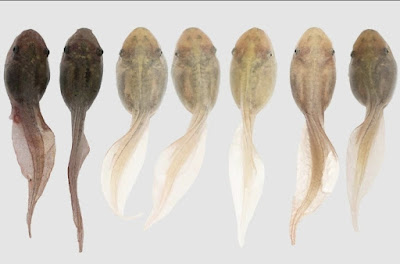When tadpoles are raised in white, black or grey trays, they adapt their colour to match their background, which may help them avoid being eaten by birds and fish.
Tadpoles can change their colour to better match their environment, making them harder for predators to spot.
 |
| Tadpoles can be darker or lighter depending on the environment they are raised in Liedtke, H.C., Lopez-Hervas, K., Galván, I. et al. |
The young amphibians are common prey for birds and fish and the ability to camouflage is probably very important for their survival, says Christoph Liedtke at the Doñana Biological Station in Seville, Spain.
To learn more about how they do this, Liedtke and his colleagues carried out experiments with western spadefoot toad (Pelobates cultripes) tadpoles. They grew five tadpoles for 40 days in each of 10 trays that were painted different colours: black, white, red, green, blue and five different shades of grey.
The tadpoles changed colour to match their background in the black, white and grey trays, but not the red, green and blue trays. This suggests that tadpoles only change their colour based on the brightness of their backgrounds and not hue or saturation, says Liedtke.
If a tadpole was moved from the darkest tray to the lightest one, or vice versa, it would change colour again.
“You can see both darkening and lightening with your eyes in 24 hours,” says Liedtke. But while a tadpole may get to its darkest level within a week, it took about three to four weeks for the tadpole to match the brightest-colour tray, he says.
Tadpoles change colour in a different way to animals like chameleons. Chameleons change colour by rearranging how pigments are distributed in a cell, which can occur very quickly.
In tadpoles, changing colour involves the active synthesis or degradation of pigments. Liedtke suspects it is quicker to produce the pigment required for darkening than it is to break down that same pigment, which explains why they are slower to change from dark to light.
Tadpoles probably need this camouflage ability because a pond can go from having very little vegetation in the early spring to far more vegetation later in the year, which makes the water darker, says Liedtke.
Journal reference:
